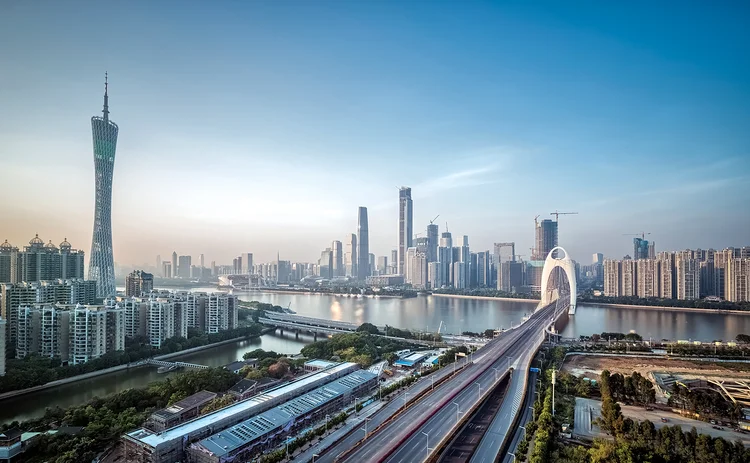
Guangzhou – A city of commerce for the millennium
Having been at the forefront of commercial innovation and foreign trade for centuries, no city is better placed than Guangzhou to become the world’s leading financial innovation centre, writes Qiu Yitong, director of the Guangzhou Finance Bureau


Guangzhou was the major port of the ancient Maritime Silk Route, thriving under the Ming and Qing dynasties, and has enjoyed a long and prosperous history of more than 2,000 years. As trade in commodities and funds in the city continues to flourish, the financial services industry in Guangzhou has also boomed, becoming the bridgehead for foreign capital into the Chinese financial market.
In recent years, finance in Guangzhou has adhered to the path of reform and innovation. The Guangzhou Private Financial Street is the first private financial hub in China that integrates capital borrowing and lending, wealth management, payment and settlement, and information release. Guangzhou established the ‘Guangzhou price’ for private financing, which became the benchmark affecting the private financing price for the entire Pearl River Delta (PRD) and China as a whole. Guangzhou started the Ligen Micro-credit Re-lending Company to provide loans to microcredit companies within Guangdong Province, which defines it as a ‘small loan central bank’ and it represents a breakthrough in creative financing channels for small loan companies in China. Relying on the Guangzhou Equity Trading Centre, China Youth GEM was first established as the integrated financial service platform for university students to start their own businesses. To date, the innovation and entrepreneurship projects of 2,407 college students in 16 provinces across the country have already launched.

The plan for a ‘financial function zone in each district’ was first set up in China, and includes Guangzhou Private Finance Street (Yuexiu District), which features peer-to-peer (P2P) finance; Guangzhou International Financial City (Tianhe District), the headquarters of numerous financial institutions; Guangzhou New Financial Innovation Service Zone (Huangpu District), a hub of technological finance; Nansha Modern Financial Service Zone (Nansha District), for cross-border finance; Guangzhou small and mini enterprises Financial Service Zone (Zengcheng District), specialising in small and micro‑finance; Guangzhou Green Finance Reform and Innovation Comprehensive Experimental Zone (Huadu District), for green finance; Bai E Tan Industrial Financial Service Innovation Zone (Liwan District), for industrial finance; Wanbo Fund Town (Panyu District), encompassing industrial funds and venture capital; Guangzhou Hot Spring Fortune Town (Conghua District); Guangzhou Ocean Bay Venture Capital Town (Haizhu District); and so on. All of these areas have effectively boosted the accumulation and balanced development of financial resources.
Guangzhou established the first financial services outlet in China and, to date, 580 community financial services outlets have been established, covering 38% of the city’s communities. Furthermore, 238 rural financial service outlets have been built to cover the entire rural area outside the city, breaking the barrier between the general public and accessible finance. Guangzhou took the lead in achieving full coverage of the industrial investment funds of the cities and districts, and was the first city in China to set up an inclusive finance industry association – the Guangzhou Pratt and Whitney Finance Association. It also built the first local financial infrastructure – the Guangzhou Financial Risk Monitoring Prevention and Control Centre, the first national centre covering nine forms of local financial risk monitoring and early warning platforms such as P2P, local trading venues, microloans, equity investments, finance leases, commercial factoring and pawn, and so on. In recent years, Guangzhou has launched four national financial reform and innovation pilots, including the PRD Financial Reform and Innovation Pilot, and the Guangzhou Green Finance Reform and Innovation Pilot, making Guangzhou the Chinese city with the greatest number of regional financial reform and innovation pilots.
A first among equals
Driven by reform and innovation, Guangzhou finance has achieved remarkable results. From 2011 to 2016, the added value of Guangzhou’s financial industry has increased by 133%, more than any other major Chinese city. It was estimated in 2017 that the added value of the financial industry would exceed RMB200 billion. The total assets of the city’s financial industry will exceed RMB7 trillion and the number of financial employees will reach 160,000, becoming the fifth pillar industry in the city, after IT, manufacturing, bio-industry and creative. Guangzhou, for the first time in 2017, was therefore incorporated into the Global Financial Centres Index system. The International Finance Forum (IFF) has permanently settled in Guangzhou and successfully held its 14th annual global conference in the city. The Wall Street Journal and Financial Times have both covered the increasing international influence of the financial industry in Guangzhou.
As a city with thousands of years of history in commerce, Guangzhou is inherently open to innovation and will give full rein to that spirit, enhancing the capability of financial services for the real economy. In the meantime, the city will reduce financial risks, optimise the financial environment and take the lead in the areas of fintech, cross-border finance, green finance, Belt and Road Initiative (BRI) finance, and Guangdong–Hong Kong–Macao finance to become a leading global financial innovation centre.
Six ways to become a financial innovation centre
1. Fintech innovation. Guangzhou was blessed with the conditions to develop fintech after HSBC established China’s only fintech innovation centre there. Furthermore, the city will create special fintech support policies and development plans, build financial- and technological-gathering areas in concentrations of technological enterprises, and improve systems to attract large financial institutions to set up fintech innovation centres in Guangzhou and test out the ‘regulatory sandbox’.
2. Supply-chain finance (SCF) innovation. As a millennial commercial city, Guangzhou has provided superior conditions for SCF. Commercial banks and third-party platforms will become the best SCF providers in the future, which will help banking institutions in Guangzhou to focus on making it a core business. At the same time, the city will strongly encourage third-party platforms such as SCF service companies to set up guidance funds.
3. Cross-border finance innovation. By making the best of the policy strength of the Guangzhou Nansha Free-Trade Zone, home to the Guangzhou Nansha Bonded Port Area, and the geographical advantage of Guangzhou in adjoining Hong Kong and Macao, new ideas on cross-border renminbi business such as two-way loans, bond issuance, settlements and capital pooling can be brought to life. Meanwhile, new ways of conducting cross-border business of both domestic and foreign currencies within the Guangzhou Nansha Free-Trade Zone with ‘NRA+’ – a non-resident account – as a special symbol can be promoted onshore, as well as at the offshore renminbi exchanges in Guangdong, Hong Kong and Macao.
4. Green finance innovation. Guangzhou has been approved by the State Council of the People’s Republic of China to build reform- and innovation-integrated pilot zones in green finance and remains the only green finance pilot zone in the four ‘first-tier’ cities in China – Beijing, Shanghai, Shenzhen and Guangzhou. It will also consolidate resources and strive to become a pinnacle of green financial innovation. For instance, local banks will be transformed into green investment banks to co-operate with major global financial institutions, research and formulate innovation policies on green finance, and establish large-scale green finance development funds to accelerate the building of the Huadu District, and strive to be the first in the country to reap favourable results that inspire other cities.
5. BRI finance innovation. Every effort will be made to encourage the Asian Infrastructure Investment Bank and the Silk Road Fund to set up branches in the Guangzhou Nansha Free-Trade Zone. Overseas renminbi investment funds for countries and regions along the BRI will provide investment and financing services for mergers and acquisitions in their enterprises’ attempts to ‘Go Out’. The multinational corporations that joined the BRI will start the centralised operation of the renminbi in Nansha and will set up settlement centres. Guangzhou will introduce funds from countries and regions along the route to participate in setting up an industrial investment fund across its districts. Guangzhou will explore the establishment of a cross-border financial assets trading platform through private equity to carry out the issuance and transfer transactions of financial securities products such as stocks, funds and bonds in Hong Kong, Macao and the countries along the Maritime Silk Road.
6. Finance innovation in the Guangdong–Hong Kong–Macao Greater Bay Area. A vigorous push for the completion of the International Commercial Bank, Guangzhou Futures Exchange and other major projects in the Greater Bay Area at an early date will be made, as well as efforts to fully use such platforms as the IFF and the China (Guangzhou) International Investment & Finance Exposition to strengthen financial exchanges between Guangzhou, Hong Kong and Macao. The co-operation between new forms of business such as fintech and digital inclusive finance in Guangzhou, Hong Kong and Macao will be improved. The Guangzhou Financial Monitoring and Prevention Centre’s findings lead to the apportionment of financial big data in these three areas. Guangzhou, Hong Kong and Macao will work together to develop the Greater Bay Area into an international financial centre that rivals New York’s bay area.
Only users who have a paid subscription or are part of a corporate subscription are able to print or copy content.
To access these options, along with all other subscription benefits, please contact info@centralbanking.com or view our subscription options here: http://subscriptions.centralbanking.com/subscribe
You are currently unable to print this content. Please contact info@centralbanking.com to find out more.
You are currently unable to copy this content. Please contact info@centralbanking.com to find out more.
Copyright Infopro Digital Limited. All rights reserved.
As outlined in our terms and conditions, https://www.infopro-digital.com/terms-and-conditions/subscriptions/ (point 2.4), printing is limited to a single copy.
If you would like to purchase additional rights please email info@centralbanking.com
Copyright Infopro Digital Limited. All rights reserved.
You may share this content using our article tools. As outlined in our terms and conditions, https://www.infopro-digital.com/terms-and-conditions/subscriptions/ (clause 2.4), an Authorised User may only make one copy of the materials for their own personal use. You must also comply with the restrictions in clause 2.5.
If you would like to purchase additional rights please email info@centralbanking.com







